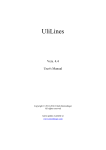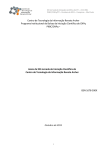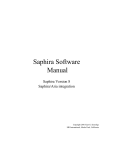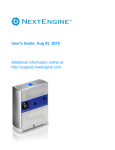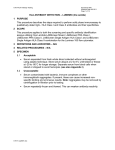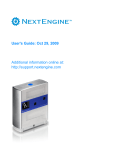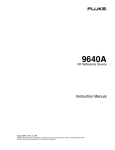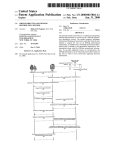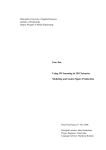Download Scan, Cleanup, and Remodel
Transcript
Using Rhinoceros Scan, Cleanup, and Remodel S C A N , C L E A N U P , A N D R E M O D E L Copyright © 2006 Robert McNeel & Associates. All rights reserved. Rhinoceros is a registered trademark and Rhino is a trademark of Robert McNeel & Associates. Copyright © 2006 Robert McNeel & Associates. ii S C A N , C L E A N U P , A N D R E M O D E L 1 Introduction This document shows how to do two things: • Bring the meshes into Rhino and clean them up, making them suitable for rapid prototype (STL) printing as a single, closed mesh. A scan from the NextEngine Desktop Scanner is used as the example. More information on the NextEngine scanner can be found at: www.nextengine.com. • Use the cleaned up mesh as a basis for making a smooth, accurate, NURBS model, suitable for any down-stream manufacturing process. Reverse Engineering – A Short Discussion There is a lot of confusion about scanning. Part of this confusion is from the misinformation passing between well-intentioned users and part is from the overly general nature of the questions asked. For our purposes, we will define reverse engineering as taking an existing object and using some process to make more. The two primary reasons for doing this are to make duplicates for reproduction and to make replacement parts. When making physical duplicate, the goal is to model as accurately as possible, preserving the odd nature and special features of the object. This might be done for historical preservation or restoration, to mass-produce a unique object like a special wood carving, or to model a damaged knee joint for a prosthetic replacement, for example. The key is preserving the detail and accuracy from the original example. When creating a new model, working from a typical example, of something that is worn or damaged, and needs to be replaced, the person doing the work needs to have a good understanding of the original part and the circumstances of its use. In this situation, the model will not precisely follow the original, in order to compensate for the wear and damage to the original. The key is to make an accurate model of what the original might have looked like before it was worn or damaged. In both of these cases, it is not possible nor realistic to think that reverse engineered part will produce an identical replacement. Close inspection and comparison will always find small differences because of the processes used and decisions made by the skilled operator. There are two primary ways to duplicate a part. One is to use a process to make a mold of the original and make castings using the mold. This process is outside the scope of this discussion. The second is to take physical measurements, or through a CMM or scanning process, and make an electronic model that in turn can be machined, or printed through one of the many rapid prototyping technologies. Generally speaking, if the part is mechanical in nature, and direct measurements can be made from the part, it is much faster to measure the part and model it using modern Computer Aided Design software like Rhino. If the part it twisty or curvy, it can be very difficult and time consuming to take direct measurements. Just ask someone that measures clay models of concept or production automobiles and creates models from the data. This is one example where scanning can save a great deal of time and capture a great deal of accuracy. When laser-scanning technology is used, best results are obtained from objects with a light colored, non-reflective matte finish. Dark, reflective, or fuzzy objects do not lend themselves to laser scanning. Additionally, scanning tends to "melt" detail. Sharp edges and creases are rounded over and filled in a little when the mesh facets are fit to the scanned point data. Copyright © 2006 Robert McNeel & Associates. 1 S C A N , C L E A N U P , A N D R E M O D E L 2 Clean-up for rapid prototype printing The NextEngine "ScanStudio" software can export to STL, VRML, OBJ, and XYZ point file formats. Rhino can read all of them. OBJ is the preferred file format. Set up Rhino display modes The five default named display settings do not lend themselves to editing dense meshes. To work with dense meshes, two new display configurations are needed. Rhino V4 offers this capability to create, name, and save them. Tools > Options > Appearance > Advanced Settings allows this. Create the first new named display configuration called Shaded Mesh Editing with the following settings: Display Mode Options Change these settings to create the two new named display configurations. All other controls should be left at default values. Name: Shaded Mesh Editing Name: Wireframe Mesh Editing Section Control Viewport settings Background: Use Application Settings Use Application Settings Shading settings Shade objects: On Off Flat shading*: On N/A Backface* Settings Single color for all backfaces Use front face settings Color: Cyan N/A Show isocurves: Off On Show mesh wires Off On Naked edge* color usage: Use single color for all naked edges Use single color for all naked edges Naked edge color: Magenta Magenta Naked edge thickness: 2 2 Color reduction %: 20 20 Visibility Objects Meshes Mesh Edge Settings *Flat shading - disables the automatic display smoothing of meshes. *Backface – Mesh facets and surfaces have front and back directions. Backfaces are oriented to be facing the interior of a closed volume. *Naked edges - are mesh or surfaces edges that are not joined to other mesh or surfaces edges. Copyright © 2006 Robert McNeel & Associates. 2 S C A N , C L E A N U P , A N D R E M O D E L Opening the scan NextEngine is ScanStudio application can export their aligned, trimmed, and blended meshes in a variety of formats. Rhino can open all of them. The preferred file format is OBJ. 1 Start a new modeling session in Rhino using the Small objects - Inches template. 2 Use File > Import, and select the Bottle.OBJ file exported from ScanStudio. It will come in as 17 different meshes grouped together. 3 Use Rhino transform commands to move and position the grouped meshes into a logical location for editing over the 0,0 origin. See the Rhino training material from information on using these transform commands. 4 Right-click the Perspective viewport title and change the display to Shaded Mesh Editing. Imported meshes showing "naked" edges in Rhino: Check the mesh The individual meshes in the OBJ file were grouped together keep them together. Ungroup them, and Join the 17 meshes into a single mesh to make them simpler to work with. The first order of business is to clear up any easily avoided problems. Rhino has several commands that are useful for checking and repairing mesh files start with: CheckMesh - Checks mesh objects for errors and reports problems, which include: • Degenerate faces - Fix with the CullDegenerateMeshFaces command. • Zero length edges - Zero-length edges typically are the result of degenerate faces. Fix with the CullDegenerateMeshFaces command. • Non-manifold edges - Use the CullDegenerateMeshFaces command and then fix with the ExtractNonManifoldMeshEdges command. • Naked edges - Naked edges are allowed, but cause problems with rapid prototyping. Use the ShowEdges command to help find them or set the display mode to paint them a different color. Try the FillMeshHole, FillMeshHoles, or MatchMeshEdge commands to remove naked edges. Copyright © 2006 Robert McNeel & Associates. 3 S C A N , C L E A N U P , A N D R E M O D E L • Duplicate faces - Fix with the ExtractDuplicateMeshFaces command. • Faces with reversed normals. Fix with the UnifyMeshNormals command. • Disjoint pieces - Fix with the SplitDisjointMesh command. • Unused vertices - Unused vertices do not usually cause a problem, and there are no commands to for removing them in Rhino. Specific details on these commands can be found in the Rhino Help file. CheckMesh reported: This is a bad mesh. Here is what is wrong with this mesh: • Mesh has 11 non-manifold edges. • Mesh has 6 duplicate faces. • Skipping face direction check because of positive non manifold edge count. Important things to consider with this mesh: • Mesh has 14044 naked edges. Although this does not necessarily mean that the mesh is bad, • Naked edges can cause problems if the ultimate goal is STL output. General information about this mesh: • Mesh does not have any degenerate faces. • Mesh does not have any zero length edges. • Mesh has 88 disjoint pieces. • Mesh does not have any unused vertices. ID: 8ba20560-dae9-483a-a801-ea150a8662b5 (49) Layer name: Default Render Material: • source = from obj • index = 20 Attribute UserData: • UserData ID: B0EE2168-8EC6-42ed-A962-26DEB8CC8F9A • Plug-in: Rhino Render • description: Rhino Renderable Object UserData • saved in file: no • copy count: 2 Geometry: • Valid mesh. • Open polygon mesh: 229147 vertices, 445784 polygons with normals • bounding box: (-0.946531,-1.08,-0.0272168) to (1.00295,0.980724,4.7215) Copyright © 2006 Robert McNeel & Associates. 4 S C A N , C L E A N U P , A N D R E M O D E L Fix mesh errors These errors indicate the following commands should be run: ExtractNonManifoldMeshEdges – Delete them after extraction Non-manifold edges are surface or mesh facets edges that are joined to two or more other edges at the same time. Rhino does not allow nonmanifold edges in surface models. ExtractDuplicateMeshFaces – Delete them after extraction Next, run the MatchMeshEdge command with a setting of 0.001". This command moves face edges of an open mesh to meet adjacent face edges exactly so the mesh will be closed and can take some time to run depending on the number of open mesh facets. This process may take about 10 minutes. Here is the result: Most of the seams are joined up but not all. After this run CheckMesh again. It may find additional non-manifold edges and duplicate faces created by MatchMeshEdge. If it does, run ExtractNonManifoldMeshEdges and ExtractDuplicateMeshFaces again and delete the extra faces. Next run the FillMeshHoles command. When automatically filling holes it can it create more nonmanifold edges. Run ExtractNonManifoldMeshEdges again and delete any extracted faces. Close the mesh All of the relatively "automatic" clean-up work has been done but we still are not quite finished. At this point the model should have an open (not water-tight) "good mesh" with a few complicated holes that still need to be fixed. The rest of the clean-up work is more manual and will require a few additional mesh editing tools. To effectively use these tools, we will be using some new display tools. In the image below, we've changed to a wire frame display (with naked edges set to magenta) to simplify selection, and zoomed in on a hole and intend to fix the hole. However, the small mesh facets on the far side of the mesh are complicating the display and will affect picking. Copyright © 2006 Robert McNeel & Associates. 5 S C A N , C L E A N U P , A N D R E M O D E L Use the ClippingPlane command to mask the mesh facets in back. Since these holes are on the front of the bottle, use the ClippingPlane command in the Front viewport. By default, the clipping plane is oriented to mask the objects in front. In this case, we want to mask the objects in back so we will Rotate the clipping plane 180 degrees. Here is a view of the Perspective viewport showing the Front viewport clipping plane: Here is the result of it in the Front Viewport: Copyright © 2006 Robert McNeel & Associates. 6 S C A N , C L E A N U P , A N D R E M O D E L Here is a shot of the Front viewport showing the results of using the ClippingPlane. Now in the front viewport, zoom in on an area with naked magenta edges. The mesh on the other side of the clipping plane will now not be displayed. In the above image, notice how some of the naked edges cross over each other? These are mesh triangles that are complicating the closing of the holes, and the reason the more automatic commands could not fix the holes for us. Use the DeleteMeshFaces command to remove the facets that are crossing over other mesh facets. Here is the same view with the overlapping mesh facets deleted. See how the hole border is now clearly shown? Use FillMeshHole (singular) to close the hole. Copyright © 2006 Robert McNeel & Associates. 7 S C A N , C L E A N U P , A N D R E M O D E L Here is the result: Sometimes it is difficult in the faster Wireframe Mesh Editing display, to see what is really going on over these complicated holes. When that happens, switch over to the Shaded Mesh Editing display mode. Then the problems will be easier to see. Here is an example of another hole with mesh facets crossing over it. Here is the same hole after deleting most of what appeared to be overlapping mesh faces Copyright © 2006 Robert McNeel & Associates. 8 S C A N , C L E A N U P , A N D R E M O D E L Well-defined holes like this one are ready for filling. The two naked edges on the right indicate some facets should be deleted before filling the hole. Use the same techniques using view clipping planes, deleting misplaced mesh facets, and filling holes, to work your way around the mesh and fix all of the holes and naked edges. Some other commands useful for doing this clean up work are: PatchSingleFace - Fills a mesh hole with a single mesh face SplitMeshEdge - Divides a mesh edge to create two or more triangles SwapMeshEdge - Transposes the corners of mesh triangles that share an edge When all of the holes are filled and the naked edges dealt with, the mesh will be closed. The Details button on the Properties dialog box will report: • Geometry: Valid mesh. Closed polygon mesh. Additionally, run CheckMesh one more time as a second check: This is a good mesh. General information about this mesh: • Mesh does not have any degenerate faces. • Mesh does not have any zero length edges. • Mesh does not have any non manifold edges. • Mesh does not have any naked edges. • Mesh does not have any duplicate faces. • Mesh does not have any faces that could make it better if their directions were flipped. • Mesh does not have any disjoint pieces. • Mesh does not have any unused vertices. ID: d7fd1a57-4be1-4636-8232-0bd7ffc58fa7 (467784) Layer name: Default Render Material: • source = from obj • index = 18 Attribute UserData: • UserData ID: B0EE2168-8EC6-42ed-A962-26DEB8CC8F9A Plug-in: Rhino Render description: Rhino Renderable Object UserData saved in file: no copy count: 179 Geometry: Copyright © 2006 Robert McNeel & Associates. 9 S C A N , C L E A N U P , A N D R E M O D E L Valid mesh. Now the mesh is closed mesh and ready for rapid-prototype printing. Copyright © 2006 Robert McNeel & Associates. 10 S C A N , C L E A N U P , A N D R E M O D E L 2 Reverse Engineer an Accurate NURBS Model Start with the cleaned-up closed mesh. Technically starting with mesh clean up first is not necessary, but it will make harvesting complete curves a little easier. Begin by using a series of commands for breaking up the mesh into logical pieces from the stand point of Rhino surface modeling. Put the different pieces on different layers to make them easier to manage. Experimenting showed that ExtractConnectedMeshFaces with a setting of less than 15 degrees worked to split the bottom of the bottle from the cap. This took advantage of the greater angle of the mesh facets in the groove between the body and cap. The next step was to split out the leaf detail on the cap. Sketch an outline curve in the top viewport and use point-editing techniques to adjust the curves. Then project the curve onto the mesh, and use MeshSplit. Copyright © 2006 Robert McNeel & Associates. 11 S C A N , C L E A N U P , A N D R E M O D E L Use a similar procedure to trim the cutaway on the bottle base, except used the apparent intersection to split the mesh instead of projecting the curve to the mesh. Split off the top of the cap the same way Harvest curves from the mesh Use the surfaces as visual reference and the symmetry of the shape, to draw curves that capture the primary shape. The Section or Contour commands can also slice through the mesh to make curves. These curves would accurately follow the mesh facets, but they would be unsuitable for making good NURBS surfaces without extensive clean up and simplification. Copyright © 2006 Robert McNeel & Associates. 12 S C A N , C L E A N U P , A N D R E M O D E L New curves ready for surface creation. Create surfaces Use NetworkSrf to make the replacement surface. Make a surface for the base using the scanned surfaces as reference. Add the bottom relief details later. Copyright © 2006 Robert McNeel & Associates. 13 S C A N , C L E A N U P , A N D R E M O D E L To model the slightly domed top, draw curves that follow the centerlines in opposite directions crossing over the middle. Then copy the curves to the ends of the other centerline curve to make a network of curves that follows the curved shape of the top. Use NetworkSrf to make the surface. Trim the three new surfaces with each other to make the basic replacement body. Here is before: Copyright © 2006 Robert McNeel & Associates. 14 S C A N , C L E A N U P , A N D R E M O D E L And after: After trimming, use ShrinkTrimmedSrf to minimize the extra control within the trimmed surfaces, and Join the surfaces into a solid. Use the same techniques of sketching curves to make a surface for the bottle cutaway. Here is the new surface and the scanned mesh for comparison. Copyright © 2006 Robert McNeel & Associates. 15 S C A N , C L E A N U P , A N D R E M O D E L The new surface fits well but shows a little undulation near the base. One way minimize this "flutter" is with a little control point nudging. This looks better: Trim and join the surfaces Trim the surfaces with each other and Join them back together. Here is what the model looks like: Copyright © 2006 Robert McNeel & Associates. 16 S C A N , C L E A N U P , A N D R E M O D E L There are still a few details to finish: splitting the cap from the bottle body, blending out the edges, adding the leaf detail to the cap, and the rim relief detail to the base. These modeling techniques are commonly used in Rhino surface modeling and not specific to reverse engineering from scanned data so they are not detailed here. Here is the finished NURBS surface model. Here is an STL mesh (on the left) generated from the closed, solid, polysurface side by side with the cleaned up scan from the original bottle (on the right). Flat shade is turned on so the individual mesh facets in both models can be seen. Copyright © 2006 Robert McNeel & Associates. 17 S C A N , C L E A N U P , A N D R E M O D E L Final results and summary Do not get the impression that one model is any "better" than the other. They are different, and each is better suited to different situations, needs and requirements. If the job is to duplicate and original as accurately as possible, capturing unique details and differences in the object as closely as possible, then scanning and leaving the data as a mesh is about as good as it can get. Sharp edges and creases in the original will be rounded a little. The little flaws in your sample (note the rippling effect in the cap from the threads) will be captured and even the thickness of the paper label can be seen. A small amount of surface noise or "orange peel" roughness is to be expected and can be seen in the apparent roughness of the scan. This can be reduced with the Rhino Smooth command. If the job is to try to reverse engineer an object from an original example, but also clean up the data in an attempt to capture the original design, then the extra work of modeling the part using NURBS surfaces may be worth the effort. Even at that, the results will not be a perfect replacement of the original because of the assumptions the Rhino operator made in the reverse engineering process. Copyright © 2006 Robert McNeel & Associates. 18




















